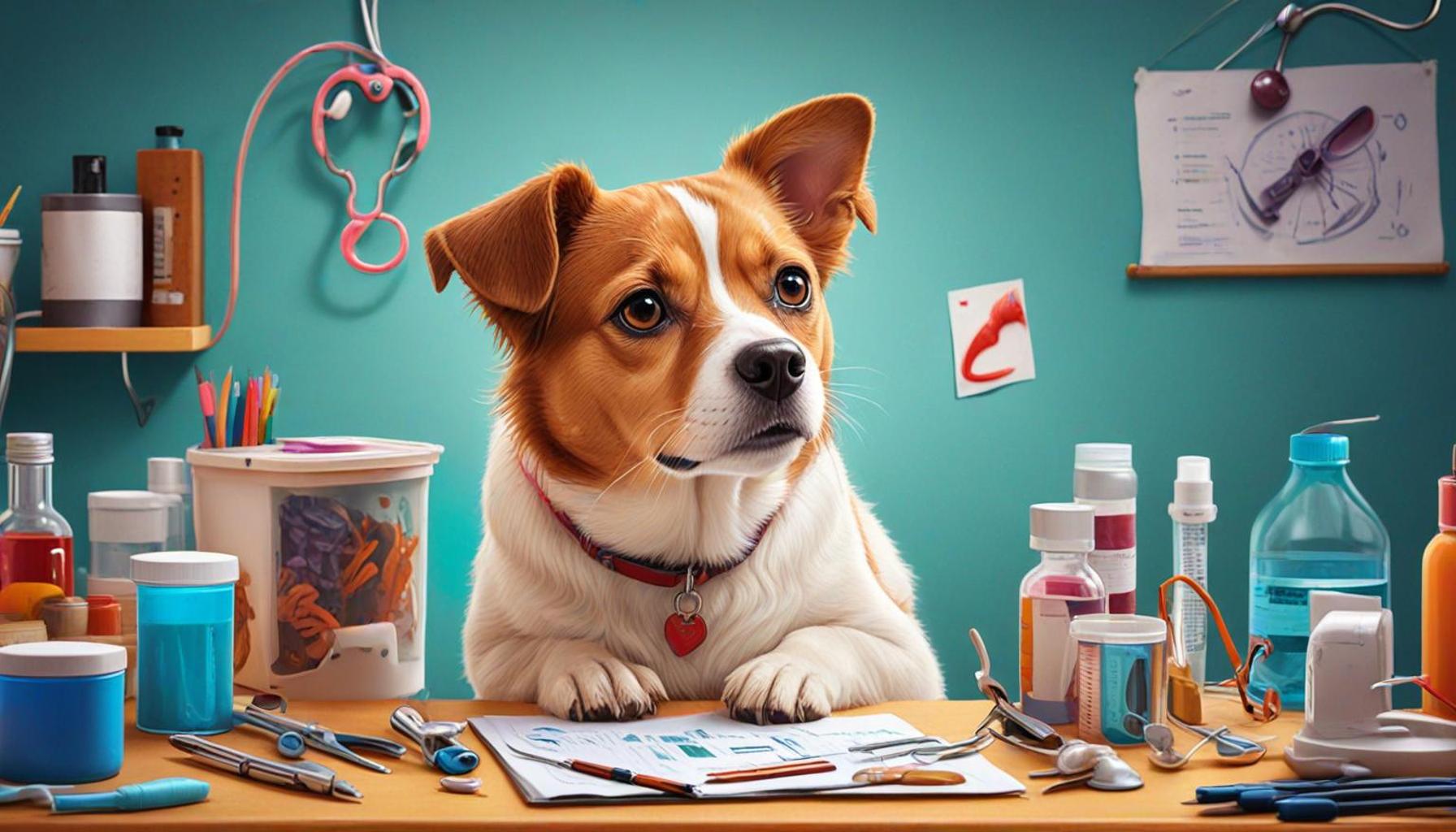How to Spot Common Pet Illness Signs A Guide for Pet Owners

The Importance of Recognizing Early Warning Signs in Pets
Every pet owner holds dear the bond they share with their furry companions. However, understanding their pet’s health can sometimes be a complex journey. Recognizing the early warning signs of common illnesses is paramount for securing your pet’s overall well-being and extending their life.
Why Timing Matters: Functionality and Treatment
The importance of early detection cannot be overstated. When symptoms are caught early, they can lead to timely veterinary care, dramatically improving the prognosis for a wide array of conditions. For example, a condition like diabetes can be managed effectively if discovered early, but could lead to more severe complications if left undiagnosed. This proactive approach can make the difference between a minor treatment and something more extensive and costly.
Long-term Health Benefits
By catching potential health issues before they escalate, pet owners can often prevent them from developing into more serious conditions. Take dental disease in dogs, for instance. What starts as mild gum inflammation could eventually result in tooth loss or even more severe systemic issues if ignored. Identifying these early signs can thus safeguard your pet’s long-term health and quality of life.
The Critical Role of Behavioral Changes
Pets often exhibit behavioral changes that might indicate underlying health issues. For example, increased sleepiness or lethargy could be early signs of serious conditions like kidney disease or thyroid imbalances. Similarly, a noticeable change in appetite, whether an increase or decrease, should not be ignored as it often points toward health concerns.
Empowerment Through Knowledge
Are you ready to become a more informed pet owner? In this article, we address the Top 5 signs to watch for, equipping you with the knowledge needed to take proactive steps in ensuring your pet’s health remains optimal. Stay tuned to learn how you can potentially save your pet’s life by recognizing subtle clues they might be giving you about their health.

YOU MAY ALSO LIKE: Read this other article
Top 5 Ways to Identify Signs of Common Diseases in Pets
Being a pet owner brings immense joy but also a hefty dose of responsibility. Among the myriad of tasks in responsible pet ownership, recognizing potential health issues in your furry companions is key. With pets often unable to directly communicate their discomfort, it’s crucial to be vigilant about the subtle signs that can indicate an underlying disease. Identifying these signs early not only ensures the well-being of your pet but can also lead to more effective treatments. Dive into the top five ways to identify common diseases in pets, helping safeguard their happiness and health.
5. Changes in Appetite
A noticeable change in appetite is often the first red flag alerting you to possible health issues in your pet. Whether your pet is overeating or suddenly disinterested in food, both scenarios can be indicative of underlying conditions that warrant attention.
For example, a loss of appetite can stem from gastrointestinal problems, dental issues like tooth pain, or even emotional stress. Conversely, an increase in appetite is sometimes linked to metabolic disorders such as diabetes or hyperthyroidism. This symptom can also indicate psychological or environmental stressors, including changes in routine or the introduction of a new pet into the household.
By documenting your pet’s eating habits in a diary, including the frequency and quantity of food consumed and any related behavioral changes, you create a valuable resource for your veterinarian. If these changes extend over a significant period, a professional consultation becomes crucial. Early intervention can prevent potential complications and lead to a quicker recovery.
4. Behavioral Changes
Behavioral changes can serve as silent cries for help from your pet. A dog who suddenly shows lethargy may be grappling with arthritis, heart disease, or even depression due to pain. Similarly, if your sociable cat becomes isolated, it might be hiding pain or discomfort.
Other key behavioral changes to monitor include:
- Avoiding usual activities like walking or playing
- Excessive seclusion or withdrawal from family
- Uncharacteristic aggression, anxiety, or restlessness
Documenting these behavioral shifts not only helps you understand your pet’s condition better but also provides your vet with critical data for diagnosis. Pets often mask their pain well, so it’s up to their owners to read between the lines.
3. Changes in Mobility
Your pet’s ease of movement can reveal much about their health. Hesitation to jump, climb, or engage in usual activities often suggests joint issues or other medical concerns.
Common indicators of mobility issues include:
- Difficulty climbing stairs or jumping onto furniture
- Limping or favoring one leg
- Stiffness, particularly after resting
Such signs are especially prevalent in older pets, who can suffer from arthritis or other degenerative diseases. Early detection and intervention can significantly enhance your pet’s quality of life. Pain relief and management, alongside more specialized treatments, can often restore mobility and joy to your furry friend’s life.
2. Skin and Coat Issues
The condition of your pet’s skin and coat is a window into their overall health. From hair loss and excessive scratching to unusual lumps or changes in coat texture, many signs warrant a closer look.
Key indicators to watch for include:
- Red, inflamed skin or rashes indicating possible allergies or infections
- Dry, flaky skin that might suggest nutritional deficiencies or parasitic infestations
- Changes in coat texture or color, pointing to possible hormonal imbalances
Regular grooming sessions with thorough checks can help detect these issues early. When persistent, these conditions should not be overlooked, as they may signal serious conditions like autoimmune diseases or cancer. Consult your veterinarian to explore the reasons and to determine an appropriate plan of action.
1. Dental Health Issues
Often underestimated, dental health significantly impacts your pet’s overall well-being. Signs like plaque buildup, bad breath, and swollen gums can indicate periodontal disease, which, if neglected, might lead to severe health issues including heart or kidney disease.
Maintaining your pet’s dental health involves consistent efforts, such as:
- Regular teeth brushing, ideally daily, using pet-safe toothpaste
- Providing dental chews and toys designed to reduce plaque and tartar
- Scheduling annual veterinary dental check-ups to monitor and treat any developing issues
If you notice anything unusual about your pet’s dental health, early consultation with a veterinarian is recommended. Regular professional dental cleanings can prevent painful conditions and costly treatments, effectively prolonging your pet’s active and healthy life.
In conclusion, vigilance and attention to your pet’s health are paramount. By recognizing these signs early, you empower yourself to take timely action, ensuring that your beloved pet receives the best care possible. Always consult with a veterinarian when concerns arise, as their expertise can guide you in making informed decisions to foster a longer, healthier life for your furry companion.
| Category | Details |
|---|---|
| Behavioral Changes | Sudden changes in behavior can indicate underlying health issues. For example, if a typically playful dog becomes lethargic or if a cat stops grooming itself, these signs might suggest pain or illness. Observing such transformations is crucial for early diagnosis. |
| Physical Symptoms | Visible signs such as coughing, sneezing, vomiting, or diarrhea often indicate health concerns. For instance, frequent vomiting can be related to dietary indiscretion or a more serious condition such as pancreatitis. Understanding these symptoms can lead to timely medical intervention. |
| Changes in Appetite | A sudden increase or decrease in appetite can be a warning sign of health issues. If a pet begins eating significantly less or shows an unexpected appetite, it may be a sign of dental issues, infections, or metabolic disorders. Recognizing these changes early can prevent complications. |
| Weight Fluctuations | A rapid change in weight, either loss or gain, can reflect serious health problems, including diabetes, thyroid issues, or certain cancers. Maintaining a close watch on your pet’s weight is essential; any noticeable change warrants a visit to the veterinarian to assess underlying causes. |
LEARN MORE: This related article may interest you
Frequently Asked Questions on Identifying Common Pet Illnesses
How can I tell if my pet is not feeling well?
Pets often exhibit subtle signs when they’re not feeling well, and understanding these can help promptly address health issues. Look for changes in appetite or behavior, unusual lethargy, or visible signs like vomiting and diarrhea. Keep an eye on physical symptoms such as coughing, sneezing, hair loss or skin irritations. If any of these symptoms persist, it is crucial to consult a veterinarian.
Are there specific symptoms I should watch for that indicate serious health problems?
Yes, there are symptoms that should be taken seriously and require immediate veterinary attention. These include difficulty breathing, excessive panting, prolonged vomiting, seizures, and uncontrolled bleeding. In such cases, time is of the essence to avoid further complications. Always err on the side of caution and seek professional help if you have any doubts regarding your pet’s symptoms.
What are the most common diseases in pets, and how can I prevent them?
Common diseases in pets include oral infections, obesity, heartworms, fleas, ticks, and intestinal parasites. Preventive measures such as regular veterinary check-ups, vaccinations, and using flea and tick prevention products can help reduce the risk of these diseases. Additionally, maintaining a balanced diet and ensuring your pet has regular exercise can proactively manage their health.
How often should I take my pet to the vet for regular check-ups?
Routine veterinary visits are essential for early disease detection and maintaining your pet’s health. It’s recommended to take your pet for a check-up at least once a year, although senior pets or those with existing health issues may require more frequent visits. Regular check-ups enable veterinarians to detect potential health threats before they become serious problems.
Is it possible to diagnose my pet’s illness at home?
While pet owners can often identify potential signs of illness, a proper diagnosis of health conditions should always be conducted by a veterinarian. Home observations can provide valuable insights, but a professional assessment is crucial to ensure that your pet receives the correct diagnosis and treatment. When in doubt, consult your veterinarian for advice.
CHECK OUT: Click here to explore more
Conclusion
In the journey of pet ownership, understanding how to identify signs of common diseases can be a crucial skill. This knowledge not only ensures the well-being of your furry companions but also enhances the bond you share with them. By being vigilant and informed, pet owners can significantly impact the health and happiness of their animals.
Key Takeaways
- Recognizing behavioral changes is vital; pets can’t vocalize their discomfort, so observing any deviation in their habits is crucial.
- Look for physical signs such as lumps, unexplained weight loss, or changes in coat condition, as these may indicate underlying health issues.
- Pay attention to eating and drinking patterns, as a sudden loss of appetite or excessive thirst could signal health concerns.
- Keep an eye on mobility; difficulty in movement might point to joint problems or pain.
- Regular veterinary check-ups are essential, providing professional assessments and early disease detection.
These steps highlight the importance of being proactively involved in your pet’s health. Awareness of the signs and symptoms of common diseases in pets allows for timely intervention, potentially saving your pet from severe medical conditions. As a pet owner, your role is pivotal in ensuring the quality of life of these beloved companions.
The importance of early detection cannot be overstated; it paves the way for effective treatments and a longer, healthier life for pets. While the responsibility may feel burdensome at times, the reward of seeing your pet thrive is immeasurable. Continuous learning and awareness are key. Dive deeper into the topic, consult with veterinarians, and always strive to offer the best care for your pets. In return, they will offer you companionship and unconditional love. This article serves as a starting point for your journey in becoming a more attentive and caring pet owner.


